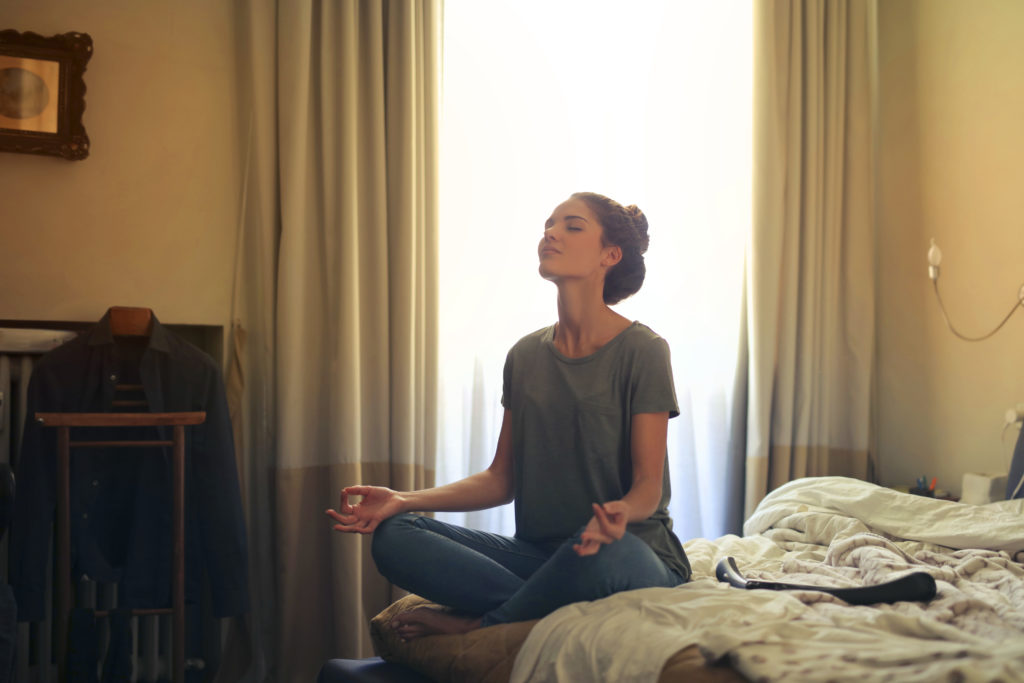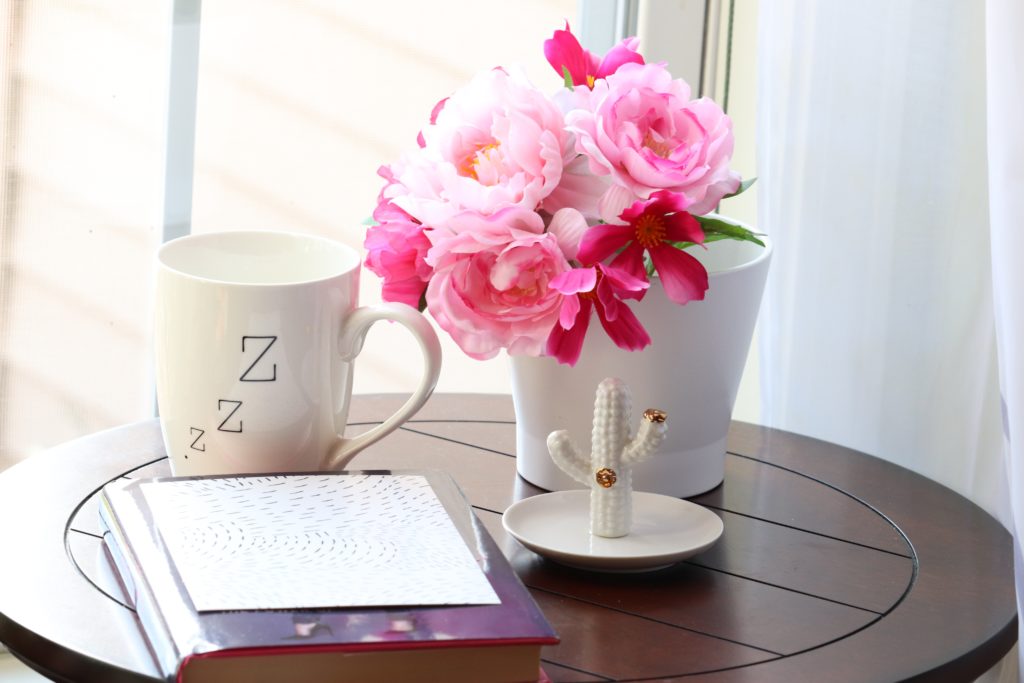What would you say if I told you that practicing gratitude (ideally writing in a journal) is an easy solution to relieve your stress, anxiety, and worries?
Every morning, as soon as I wake up, I immediately think about 3 things that I am grateful for. No matter what happened the previous day, I try to think about what I currently appreciate. This gratitude practice sets a positive foundation for my day. In the evening, before I go to sleep, I record 3 things that I’m grateful for in my gratitude journal.
My daily gratitude practice has made such a clear shift in my life.
I have noticed significant improvements in numerous areas including my work, relationships, and most importantly, my health and well-being.

There are numerous benefits of having a regular gratitude practice.
For one, gratitude remarkably creates chemical changes in your brain, which causes a positivity chain reaction.
In fact, gratitude increases dopamine, the feel-good chemical in your brain.
Next, dopamine increases your level of happiness (this begins a positive feedback loop) which in turn activates the “learning centers” in your brain which make you happier and thereby smarter.
In this article, you will learn about some simple tips, activities, and research on how you can learn to shift your attention, feel more gratitude, and even rewire your brain for more positivity.
Science shows the benefits of a gratitude practice
Multiple studies have shown that people who regularly practice feeling thankful have a demonstrative difference in their overall health and well-being.
More importantly, psychology professor Robert Emmons, from the University of California at Davis, and lead researcher in positive psychology has found that those who adopt an “attitude of gratitude” as a permanent state of mind experience many health benefits.
Psychologists and researchers have discovered that people who practice gratitude are more likely to:
- Take better care of themselves physically and mentally
- Engage in more protective health behaviors and maintenance
- Get more regular exercise
- Eat a healthier diet
- Have improved mental alertness
- Schedule regular physical examinations with their doctor
- Cope better with stress and daily challenges
- Feel happier and more optimistic
- Avoid problematic physical symptoms
- Have stronger immune systems
- Maintain a brighter view of the future
With that list of benefits, who wouldn’t want to try it?
To learn more about the science and research behind a regular gratitude practice, check out The Science of Gratitude.
Though you may start feeling the effects of starting a daily gratitude practice early on, you actually need to continue for more than just a few days.
Research suggests that the long-term benefits become significant after a month of journaling and increase over time.
So keep going, don’t give up after the first week!
How to get started with a gratitude practice
To get started with a gratitude practice, consider integrating some of the steps below into your daily life.
Focus Attention Outward
Your attitude plays a large role in determining whether you can feel grateful in spite of life’s challenges.
According to Emmons, gratitude is defined by your attitude towards both the outside world and yourself. He suggests that those who are more aware of the positives in their lives tend to focus their attention outside of themselves.
Moreover, positive psychologists often mention gratitude and thanking as two of the best practices for fostering happiness.
So one practice you can integrate into your life is to focus on what is going well and really take a moment to appreciate it.

Oftentimes we take the little things in life for granted, and we do not realize how important they are until we can not have them anymore.
So now is a good time to take stock of what you truly value and what brings you joy. In doing so, you realize how fortunate you truly are.
You can also be more generous with your gratitude by verbally expressing it to your loved ones.
For example, call your friend instead of texting them to let them know how much you appreciate their presence in your life.
Appreciate what you have
You may assume that those with more material possessions have more to be grateful for.

However, research suggests otherwise.
Edward Diener, a psychology professor at the University of Illinois, found that a high percentage of affluent people in Japan report low levels of life satisfaction, just as those living in poverty in India do.
“Happiness is like a butterfly; the more you chase it, the more it will elude you. But if you turn your attention to other things, it will come and sit softly on your shoulder.”
Henry David Thoreau
These findings suggest that it’s not how much you have, but how you feel about what you have that makes the difference.
If you would like to watch a video that can help you better understand this, check out the documentary Happy.
This powerful documentary really shifted my views in so many ways. Oftentimes people think that happiness is associated with more money or material wealth.
In contrast to this, Happy shows the wisdom of traditional cultures as well as demonstrating that 40% of your happiness is correlated with “intentional activity” or actions that you choose to do.
You will learn about simple practices that you can incorporate in your life now to start feeling happier and more thankful.
Practice mindfulness and gratitude regularly
Do you think that you often overlook and perhaps take for granted the simple things in life that bring you joy?
You’re not alone.
You would be surprised but it’s actually more important to enjoy the small pleasures in our life rather than the big ones.
The reason is that when you practice gratitude regularly, you rewire your brain.
“The practice of gratitude increases your dopamine production which encourages your brain to seek our more of the same. It’s the brain saying, “Oh, do that again” which means the more you are grateful for, the more you will find to be grateful for.”
Carrie D. Clarke, JD, ACC How gratitude actually changes your brain and is good for business
In short, mindfulness is the act of paying attention to the present moment without judgment.
Ready to get started? Check out The best meditation tips for beginners.

Start incorporating mindfulness in your daily life by bringing your attention to the little things you appreciate.
For example, next time you have a piece of chocolate, savor the taste in your mouth.
When you have your cup of coffee in the morning, slow down and smell the scent. Enjoy the softness of your plush pillow at night and the firmness of your mattress.
Learn to reframe difficult situations
It’s not actually a challenging situation that is upsetting. It’s how you perceive and react to the situation.
“Appreciation is a wonderful thing. It makes what is excellent in others belong to us as well.”
Voltaire
The next time you find yourself complaining about the changes, stressors or challenges that you’re facing, try to “flip the switch” to frame things differently.
For example, rather than getting distressed or starting a narrative in your mind about something that you weren’t expecting, try to see a different angle or positive side.

It takes some time to practice reframing situations but one way you can do this is to call a friend and talk about it.
When you express your thoughts rather than internalize them, it’s much easier to reframe them. In addition, getting a different perspective always helps.
Start writing in a gratitude journal
Recording what you feel grateful for in a journal is a great way to give thanks on a regular basis.
Emmons found that those who listed five things they felt grateful for in a weekly gratitude journal reported fewer health problems and greater optimism than those who didn’t.
A second study suggests that daily writing led to a greater increase in gratitude than weekly writing.

Gratitude journaling is the practice of writing and reflecting on things (typically three) that you are grateful for on a regular basis.
In essence, you are rewiring your brain to focus more on the positive aspects of your life and build up resilience against negative situations.
The physical format of your gratitude journal is not nearly as important as how you use it.
You can use a journal that you keep next to your nightstand and record your daily entries. Or download an app like HappyFeed or The Five-Minute Journal.
I love using HappyFeed and have done so for over 3 years. You can take photos and use emojis to reflect on what you are grateful for that day.
7 tips for keeping a gratitude journal
Gratitude seems like a simple enough concept, right?
You can probably think of a few things right now: your family, your friends, health… that’s three, easy!
1. Enjoy the little things
Specifics are what make your gratitude journal unique and full of wonderful surprises when you look back at previous entries.
Instead of writing “I’m grateful for my friends” consider writing what happened that day.
For example “I’m so happy that Kelli and Rylee stopped by tonight and brought cookies for us.”
2. Try to avoid recording the same thing
Perhaps you’re practicing gratitude and thinking about your partner or family every day.
That’s ok and you can also mix it up with other parts of your life like work, relationships, or health.
This can keep the practice “fresh” and extend the effectiveness of gratitude journaling.
3. Be specific about people and places
In addition to avoiding repetition, noting specific people and places will help keep things fresh.

Not only will you learn more about who and what affects your happiness but you will have an actual record of these things to reflect on in the future.
Surprisingly I learned through my 3 years of recording in my journal on HappyFeed that interacting with children and animals regularly makes me very happy.
4. It’s ok if you had a bad day
Like Alexander, occasionally you too will have a “Terrible, Horrible, No Good, Very Bad Day”
Despite having an awful day, gratitude journaling is even more important.
In doing this practice, you will learn to push aside the negativity and find that you can be grateful for the simple things in your life like having a warm cup of coffee in the morning.
5. Enjoy being creative and writing
Have some fun with your posts! Throw in some extra adjectives, try to describe your experience with details and photos.
6. Make it a habit
Research has shown that it’s most effective if you’re writing in a gratitude journal at night before bed.
Setting a reminder or pairing it with another habit (brushing your teeth, meditating) will make it easier to be consistent.
7. Mention surprises
Not every day will have these, but reflecting on surprises is a useful way to avoid repetition and savor your best days.
Wrap-up
Learning about the effectiveness and value of a daily gratitude practice has completely shifted my life.
Positive psychologists and researchers have pointed out the remarkable efficacy of this practice as well as the numerous benefits it has for your physical, emotional, and mental health.
To get started, start to appreciate and take stock of what you have, practice mindfulness and gratitude regularly, and learn to reframe difficult situations.
In addition, start using a daily gratitude journal.
Find a journal that works best for you. Perhaps you buy a journal to have beside your nightstand or you choose to use an app on your phone.
As you cultivate this new habit, you’ll figure out what works best for you and start integrating those activities into your daily life.
Most of all, learning these new habits and practicing gratitude will help you become happier, and more balanced, and enhance your well-being.
Have you ever tried a daily gratitude practice? Do you use an app or journal to record your gratitude? Please share your stories and comments below.




10 Responses
I do have the grateful thoughts – but I need to put them down on paper and start a gratitude journal. Looking forward to seeing that have a positive impact!
Thanks Sheila for the positive feedback. I’m happy to hear that you’re having grateful thoughts. The benefit of writing them down is that we can reflect on them in the future. Using the HappyFeed app is perfect since it’s free and you can look at your past posts for inspiration.
Wow! great article. So well-written and inspiring. I will start keeping a gratitude journal now. Thank you so much for this great information.
Thanks for the positive feedback Jane and I’m happy that I’ve inspired you to start a gratitude journal.
Remaining mindful and practicing gratitude is so important and necessary to maintain a sincere thankful heart. It changes your perspective. Thank you for sharing this post. 😊
Pastor Natalie (Examine This Moment)
Letstakeamoment.com
Thank you Natalie and I wholeheartedly agree that practicing gratitude helps shift our perspective and gain more positivity.
Gratitude is important in our daily lives. I try to take a few minutes each night and reflect on the things that I appreciate. Thanks for sharing.
I love that you take a few minutes to reflect on the things that you appreciate. Taking a few minutes day or night to practice gratitude helps us immensely both physically and emotionally.
Wow…Wonderful.
I am familiar with this topic and I always encourage family and friends to see life with an open mind: reality is more than what our senses can perceive and everything is energy.
You remind me the book” The Verity of your Health. Unraveling the Essence of Well-being: a Journey through Body, Mind and Spirit.”
Good job!
More people should know about those info🙏🏻
Hi Ed thank you so much for the positive feedback and the recommendation of the book. It’s helpful to learn new resources. I love that you said that reality is more than what our senses can perceive and everything is energy. I agree with you and appreciate your insight.